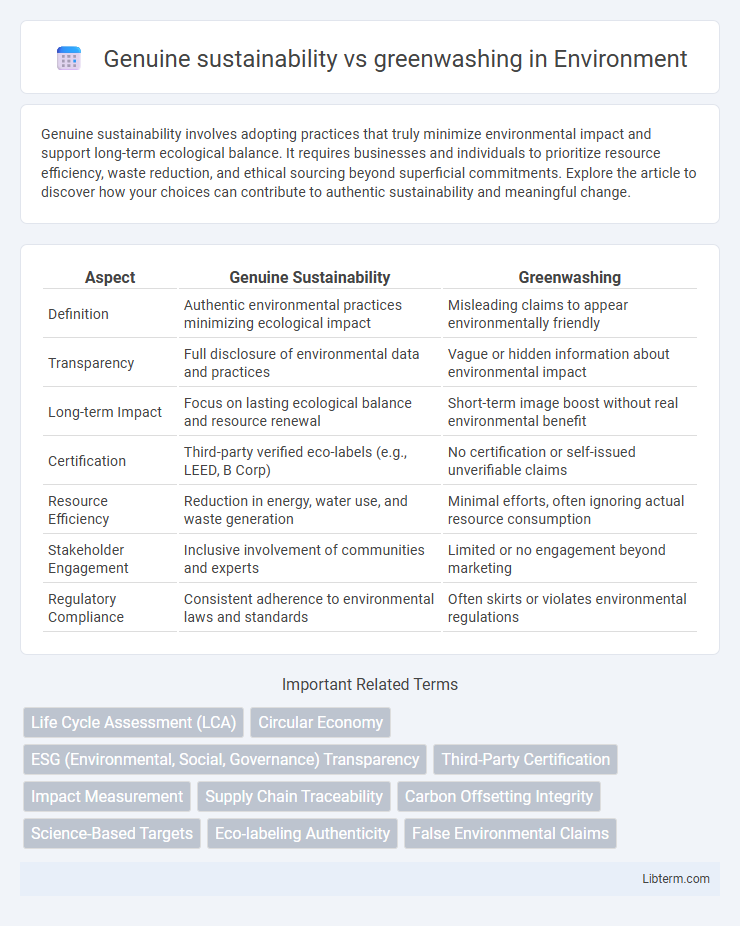Genuine sustainability involves adopting practices that truly minimize environmental impact and support long-term ecological balance. It requires businesses and individuals to prioritize resource efficiency, waste reduction, and ethical sourcing beyond superficial commitments. Explore the article to discover how your choices can contribute to authentic sustainability and meaningful change.
Table of Comparison
| Aspect | Genuine Sustainability | Greenwashing |
|---|---|---|
| Definition | Authentic environmental practices minimizing ecological impact | Misleading claims to appear environmentally friendly |
| Transparency | Full disclosure of environmental data and practices | Vague or hidden information about environmental impact |
| Long-term Impact | Focus on lasting ecological balance and resource renewal | Short-term image boost without real environmental benefit |
| Certification | Third-party verified eco-labels (e.g., LEED, B Corp) | No certification or self-issued unverifiable claims |
| Resource Efficiency | Reduction in energy, water use, and waste generation | Minimal efforts, often ignoring actual resource consumption |
| Stakeholder Engagement | Inclusive involvement of communities and experts | Limited or no engagement beyond marketing |
| Regulatory Compliance | Consistent adherence to environmental laws and standards | Often skirts or violates environmental regulations |
Understanding Genuine Sustainability: Core Principles
Genuine sustainability prioritizes long-term environmental stewardship, social responsibility, and economic viability by integrating renewable resources, reducing carbon footprints, and promoting fair labor practices. It requires transparent reporting, measurable impact assessments, and continuous improvement to ensure authentic progress toward sustainable development goals. Unlike greenwashing, genuine sustainability involves verifiable actions and commitments that align corporate practices with global environmental standards.
Unmasking Greenwashing: Common Tactics and Red Flags
Unmasking greenwashing involves recognizing common tactics such as vague claims, misleading labels, and selective disclosure of environmental benefits. Companies often highlight minor eco-friendly initiatives while ignoring significant environmental harms, creating a false impression of genuine sustainability. Red flags include lack of third-party certification, ambiguous language like "eco-friendly" without specifics, and inconsistent sustainability reporting.
Environmental Impact: Real Solutions vs Superficial Claims
Genuine sustainability involves measurable reductions in carbon emissions, waste, and resource consumption, leading to long-term positive environmental impact. Greenwashing relies on superficial claims and vague commitments without verifying actual performance or accountability. Companies practicing true sustainability invest in renewable energy, circular economy practices, and transparent reporting to demonstrate real ecological benefits.
Transparency and Accountability in Sustainable Practices
Transparency and accountability are critical in distinguishing genuine sustainability from greenwashing, as companies committed to true sustainable practices openly disclose detailed environmental impact data and third-party audit results. Authentic sustainability initiatives involve clear reporting on resource usage, emissions, and social responsibility outcomes, backed by verifiable certifications such as B Corp or LEED. In contrast, greenwashing often relies on vague claims, selective disclosure, and lack of measurable targets, undermining consumer trust and obstructing progress toward real environmental goals.
Corporate Social Responsibility: Substance Over Spin
Corporate Social Responsibility (CSR) demands authentic commitment to environmental and social goals rather than superficial marketing tactics. Genuine sustainability integrates measurable impact, transparent reporting, and stakeholder engagement to drive long-term value. Greenwashing, by contrast, undermines trust through misleading claims that prioritize image over real environmental progress.
Regulatory Frameworks and Industry Standards
Regulatory frameworks such as the EU Taxonomy and the U.S. Securities and Exchange Commission's proposed climate disclosure rules establish clear criteria for genuine sustainability, helping to differentiate it from greenwashing. Industry standards like the Global Reporting Initiative (GRI) and the ISO 14001 environmental management system provide transparent guidelines for measuring and reporting environmental performance. These frameworks and standards enhance accountability, ensuring companies adopt authentic sustainable practices rather than superficially promoting eco-friendly claims.
Consumer Awareness: Empowering Informed Choices
Consumer awareness plays a crucial role in distinguishing genuine sustainability efforts from greenwashing practices in the market. Educated consumers use tools like eco-labels, third-party certifications, and transparent corporate reports to assess a product's environmental impact accurately. Empowering informed choices drives demand for authentic sustainable products, encouraging companies to adopt real eco-friendly practices rather than superficial green marketing.
The Role of Certification and Third-Party Verification
Certification and third-party verification serve as critical mechanisms to distinguish genuine sustainability efforts from greenwashing by providing transparent, credible, and standardized assessments of environmental practices. Recognized certifications such as LEED, B Corp, and Fair Trade verify compliance with rigorous sustainability criteria, enhancing consumer trust and corporate accountability. These independent validations reduce misinformation, compelling companies to meet measurable sustainability goals and fostering authentic progress in environmental stewardship.
Case Studies: Success Stories and Notorious Greenwashers
Unilever's commitment to genuine sustainability is exemplified by its Sustainable Living Plan, which has reduced environmental impact while boosting growth across brands like Dove and Ben & Jerry's. In stark contrast, Volkswagen's 2015 emissions scandal stands as a notorious example of greenwashing, where software manipulation falsely promoted lower emissions. Patagonia's transparent supply chain initiatives and dedication to environmental activism further highlight authentic sustainability as a viable business model.
Future Trends: Advancing Authentic Sustainability
Future trends in advancing authentic sustainability emphasize transparent supply chains powered by blockchain technology to verify eco-friendly practices. Emerging standards and certifications driven by AI analytics enhance accountability, reducing greenwashing risks. Consumer demand for verifiable impact metrics fuels innovation in sustainable product design and corporate reporting.
Genuine sustainability Infographic

 libterm.com
libterm.com